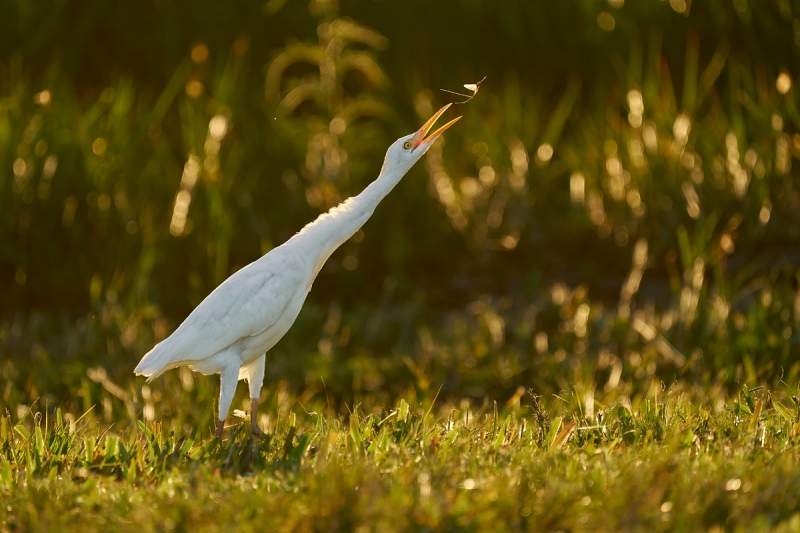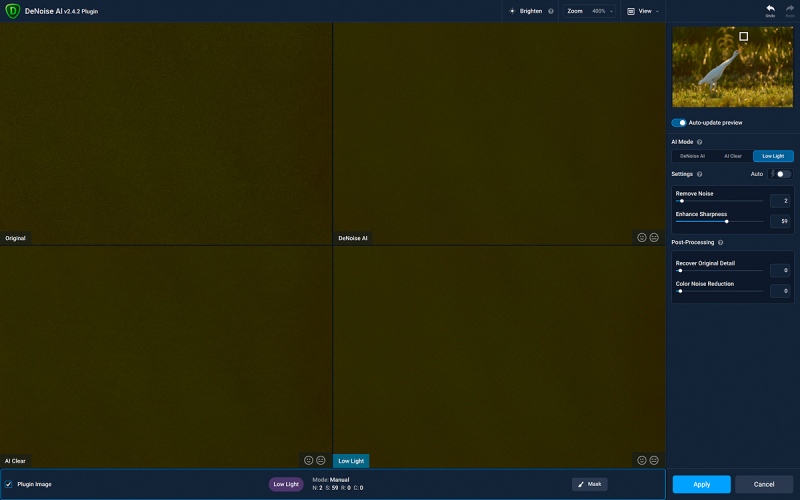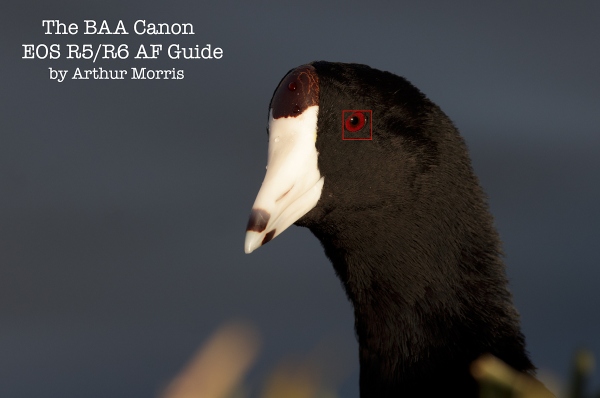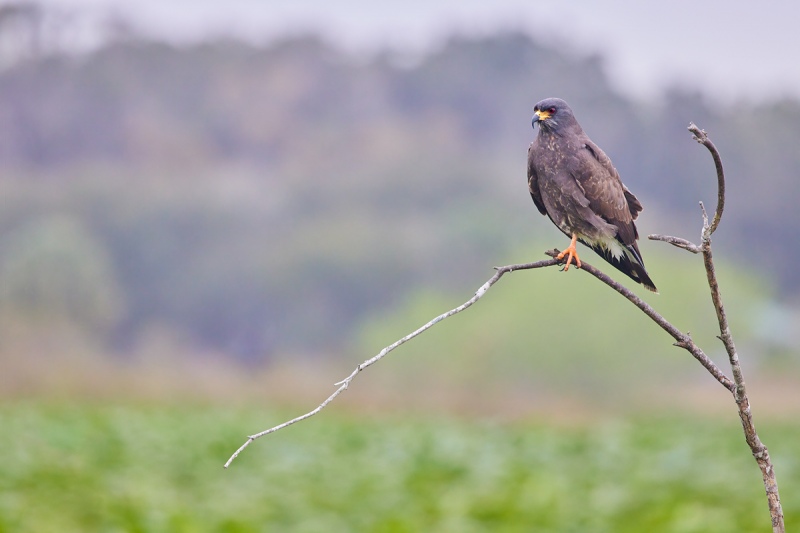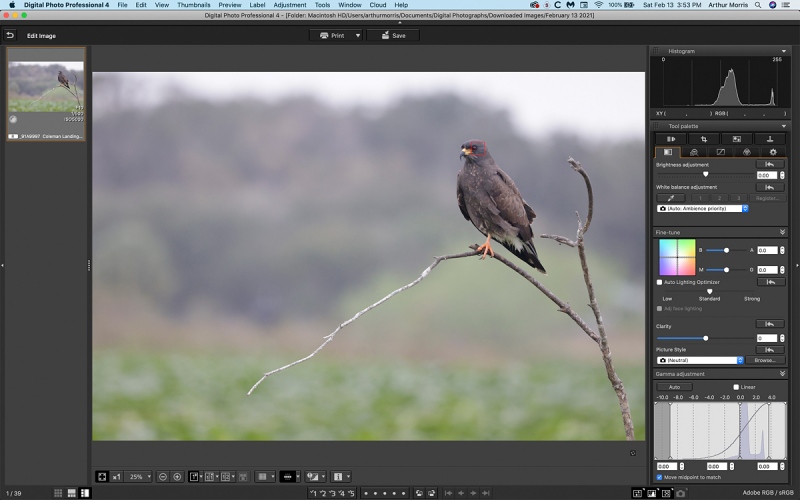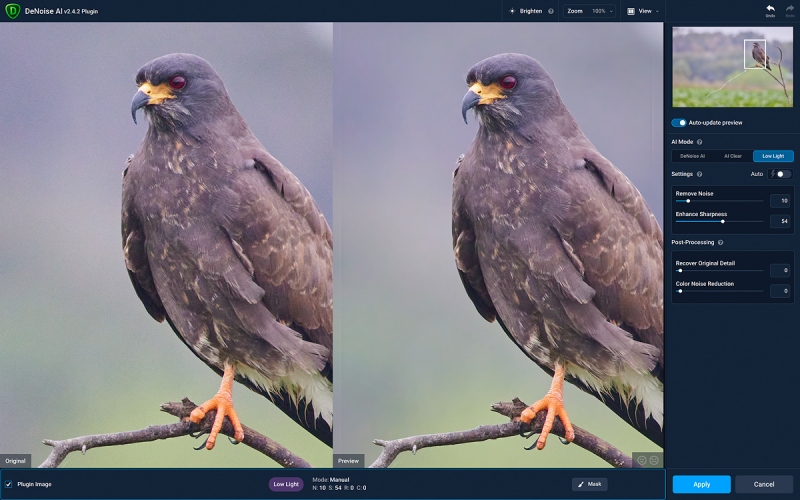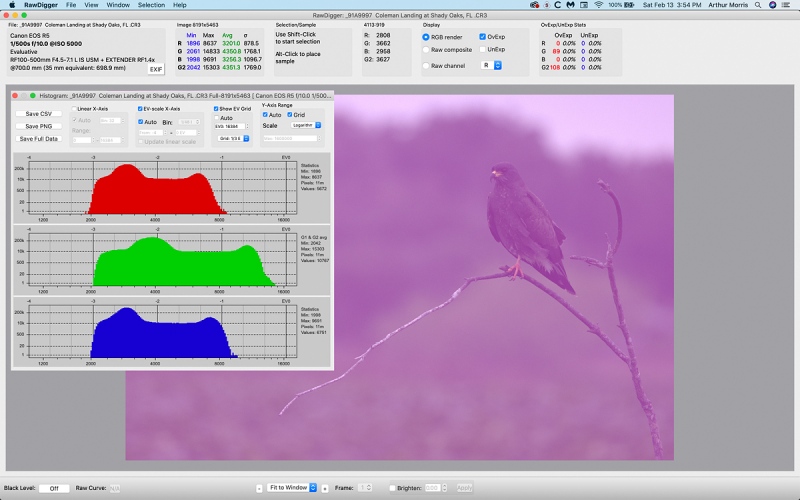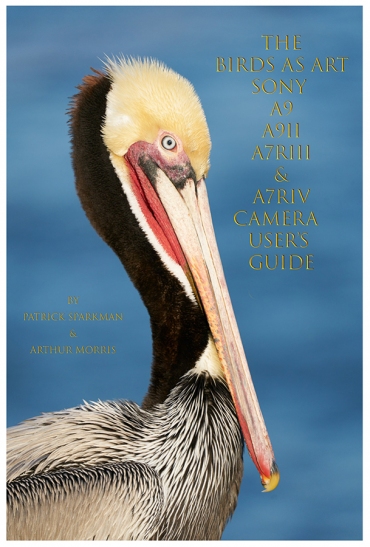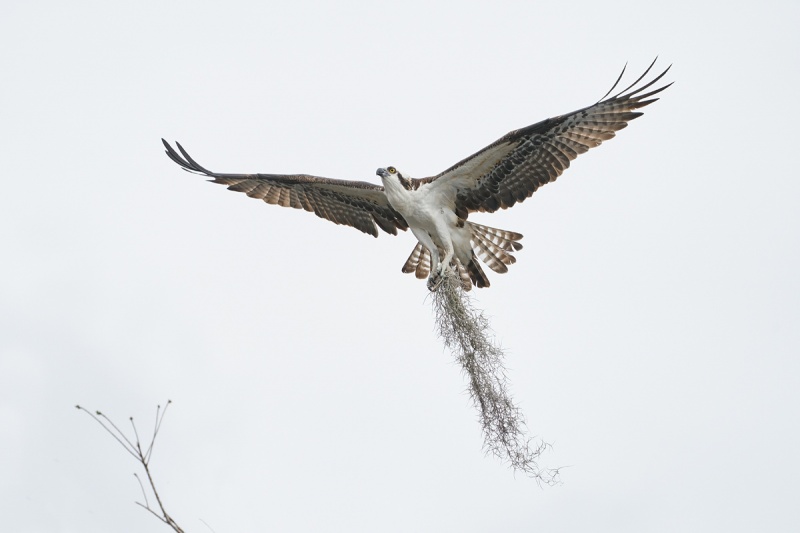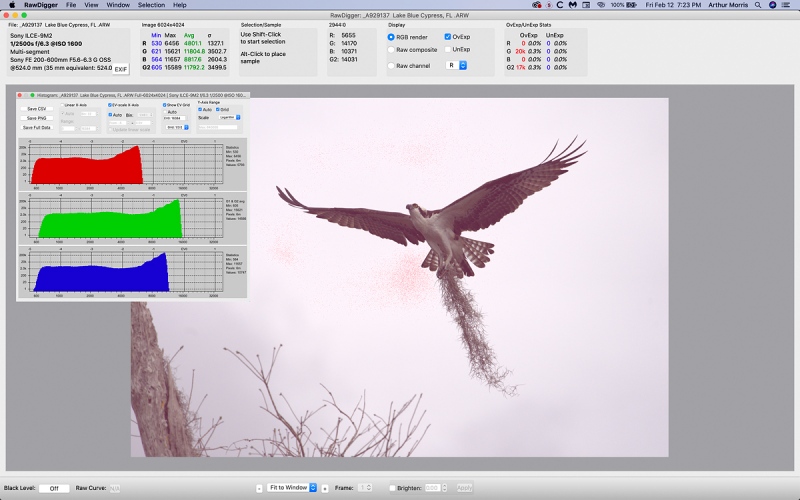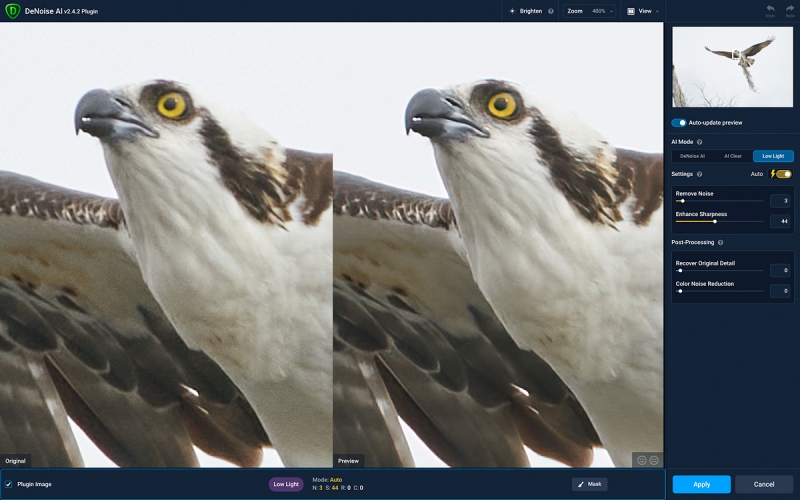Specular Highlight Question
With today’s featured image, would you have taken steps during post-processing to reduce or eliminate all or some of the super-bright specular highlights in the background, or left them as is? Reduce, eliminate or leave them as is? Why?
What’s Up?
It was pouring at 5:00am. It was cloudy-dark at 8:00am. And sunny by 8:30am. All in all, I did fairly well on Sunday morning photographing (mostly) perched Black Vultures. They were cleaner-than-usual because of the rain; they look quite nice when they are not splattered with whitewash. And a neighbor-friend pointed out the first crane nest of the year.
I did a lot of relaxing during the day and upped my swim to 60 slow lengths (88 to the mile). Sunday sunset was looking promising until a huge gray cloud took over …
Today is Monday 15 February. The forecast for the morning is for partly cloudy with south winds. The armadillo might come out of its cooler.
This post took about 1 1/2 hours to prepare and makes fifty-eight days in a row with a new one. Please remember…
Please Remember
With income from IPTs now at zero, please, if you enjoy and learn from the blog, remember to use one of my two affiliate programs when purchasing new gear. Doing so just might make it possible for me to avoid having to try to get a job as a Walmart greeter and will not cost you a single penny more. And if you use Bedfords and remember to enter the BIRDSASART code at checkout, you will save 3% on every order and enjoy free second-day air shipping. In these crazy times — I am out at least forty to sixty thousand dollars so far due to COVID 19 (with lots more to come) — remembering to use my B&H link or to shop at Bedfords will help me out a ton and be greatly appreciated. Overseas folks who cannot order from the US because of import fees, duties, and taxes, are invited to help out by clicking here to leave a blog thank you gift if they see fit.
New Listings
Sony FE 400mm f2.8 GM OSS Lens (with Extras)
IPT veteran Mike Ross is offering a Sony FE 400mm f2.8 GM OSS lens in like-new condition for $9998.00. The sale includes the lens trunk, the original box and everything that came in it, a LensCoat, a Wimberly replacement foot, and insured UPS ground shipping to lower-48 US addresses. Your new lens will not ship until payment clears unless other arrangements are made.
Please contact Mike via e-mail.
Patrick Sparkman owned and use this super-fast, super-sharp lens and rues the day he sold it. It produces the world’s sweetest background, is extremely close focusing, and kills with either teleconverter. This great lens sells new for $11,998.00 so you can save $2000.00 by being the one to grab Mike’s pretty much new lens. artie
Sony FE 100-400mm f/4.5-5.6 GM OSS Lens
IPT veteran Mike Ross is offering a Sony FE 100-400mm f/4.5-5.6 GM OSS lens in like-new condition for $1898.00. The sale includes the original box and everything that came in it and insured UPS ground shipping to lower-48 US addresses. Your lens will not ship until payment clears unless other arrangements are made.
Please contact Mike via e-mail.
This lens was my primary lens on that last Galapagos Photo-Cruise. It performed fabulously on boobies, Flightless Cormorants, Waved Albatrosses, tortoises, iguanas, Sally Lightfoot Crabs, and anything I pointed it at. It focuses to just over three feet making it great for medium-sized flowers, snakes, frogs, and turtles. A new one sells for $2,398.00. You can save a very nice $500.00 by grabbing Mike’s copy. artie
Sony Alpha a9 ii Mirrorless Digital Camera Body
BAA Record-low Price
IPT veteran Mike Ross is offering a Sony a9ii mirrorless digital camera body in like-new condition with only 50 shutter actuations for a BAA record-low $3197.00. The sale includes the original box and everything that came in it and insured UPS ground shipping to lower-48 US addresses. Your new camera will not ship until payment clears unless other arrangements are made.
Please contact Mike via e-mail.
From the moment I tracked that first incoming Brandt’s Cormorant, I knew that SONY a9 series bodies featured the world’ best AF. I upgraded to the a9 ii as soon as it was released for the slightly larger body size. I currently own and use two of them. A new a9 ii sells for $4,498.00. You can save a very nice $1301.00 by grabbing Mike’s a9 ii. Not to mention that the new Sony A1 sells for $6498.00 … artie
Sony Alpha a9 Mirrorless Digital Camera Body with Extras
BAA Record-low Price
IPT veteran Mike Ross is offering a Sony a9 mirrorless digital camera body in like-new condition with only 341 shutter actuations for a BAA record-low $1996.00. The sale includes the original box and everything that came in it, one extra SONY battery, the Sony VG-C3EM Vertical Grip (a $248 value), and insured UPS ground shipping to lower-48 US addresses. The vertical grip makes hand holding and operating the camera much easier, especially with telephoto and telephoto zoom lenses. Your new camera will not ship until payment clears unless other arrangements are made.
Please contact Mike via e-mail.
From the moment I tracked that first incoming Brandt’s Cormorant, I knew that SONY a9 series bodies featured the world’ best AF. A new a9 sells for $2,998.00. You can save a very nice $1002.00 by grabbing Mike’s a9. Not to mention that the new Sony A1 sells for $6498.00 … artie
Sony Alpha a7r iii Mirrorless Digital Camera Body with Extras
IPT veteran Mike Ross is offering a Sony a7r iii mirrorless digital camera body in like-new condition with only 8052 shutter actuations for $1498.00. The sale includes the original box and everything that came in it, one extra SONY battery, the Sony VG-C3EM Vertical Grip (a $248 value), and insured UPS ground shipping to lower-48 US addresses. The vertical grip makes hand holding and operating the camera much easier, especially with telephoto and telephoto zoom lenses. Your new camera will not ship until payment clears unless other arrangements are made.
Please contact Mike via e-mail.
The a7r iii was my primary camera body on my last Galapagos Photo-Cruise. It performed fabulously and did well with birds in flight. A new a7r iii sells for $2,298.00. You can save a very nice 800.00 and enjoy some great extras by grabbing Mike’s a7r iii. artie
Canon EF 400mm f/4 DO IS II USM Lens with Extras
IPT veteran Mike Ross is offering a Canon EF 400mm f/4 DO IS II USM lens in like-new condition for $3898.00. The sale includes the lens trunk, the original box and everything that came in it, a LensCoat, a Kirk replacement foot, and insured UPS ground shipping to lower-48 US addresses. Your lens will not ship until payment clears unless other arrangements are made.
Please contact Mike via e-mail.
I owned and used and loved the 400 DO II when I shot with Canon and found a way to take it on most trips. I took it to Scotland and Nickerson Beach and San Diego. It served me well as my (lighter!) big gun several Galapagos and Southern Ocean (the Falklands and South Georgia) trips. With an R5 or an R6 it will be a killer for flight photography with or without the 1.4X III TC. It is razor-sharp with the 2X on static subjects and skilled folks have had amazing success hand holding it with the 2X III TC for flight and for action. This great lens sells new for $6,899.00 so you can save a very nice $3000.00 by being the one to grab Mike’s like-new lens. artie
Canon Extender EF 1.4x III
IPT veteran Mike Ross is offering a Canon Extender EF 1.4X iii in like-new condition for a very low $219.00. The sale includes the original box,, the front and rear caps, the pouch, and insured ground shipping via major courier to lower-48 US addresses only. Your item will not ship until your check clears unless other arrangements are made.
Please contact Mike via e-mail.
As regular readers know the 1.4X TCs are so important to what I do with a long lens that I always travel with one or two back-ups!. artie
Great Topaz News!
Folks who use the BAA Topaz link to purchase Sharpen AI, DeNoise AI, or the Utility Bundle (or any other Topaz plug-ins) will receive a 15% discount by entering the ARTHUR15 code at checkout. If the stuff is on sale (as it usually is), you save 15% off of the sale price! To get the discount you must use my link and you must enter the discount code. Be sure to start with this link.
Those who purchase Sharpen AI, DeNoise AI, or any other Topaz plug-ins using my link and then entering the ARTHUR15 code at checkout can e-mail to request a short Getting Started with Topaz e-Guide. Please include a copy of your Topaz receipt that shows the discount. Aside from the basics, the guide explains how to install the plug-ins so that they appear in the Photoshop Filter Menu.
New and Better Bedfords Discount Policy!
You can now save 3% on all of your Bedfords photo gear purchases by entering the BIRDSASART coupon code at checkout. Your discount will be applied to your pre-tax total. In addition, by using the code you will get 2nd day air shipping via Fed Ex.
Grab a Nikon AF-S Teleconverter TC-14E III and save $14.99. Purchase a Canon EOS R5 and your discount will be $116.97. Purchase a Sony FE 600mm f/4 GM OSS lens and save a remarkable $389.94! Your Bedford’s purchase no longer needs to be greater than $1,000.00 for you to receive a discount. The more you spend, the more you save.
Money Saving Reminder
Many have learned that if you need a hot photo item that is out of stock at B&H and would enjoy free second-day air shipping, your best bet is to click here, place an order with Bedfords, and enter the coupon code BIRDSASART at checkout. If an item is out of stock, contact Steve Elkins via e-mail or on his cell phone at (479) 381-2592 (Central time). Be sure to mention the BIRDSASART coupon code and use it for your online order to save 3% and enjoy free 2nd-day air shipping. Steve has been great at getting folks the hot items that are out of stock at B&H and everywhere else. The wait lists at the big stores can be a year or longer for the hard to get items. Steve will surely get you your gear long before that. For the past year, he has been helping BAA Blog folks get their hands on items like the SONY a9 ii, the SONY 200-600 G OSS lens, the Canon EOS R5, the Canon RF 100-500mm lens, and the Nikon 500mm PF. Steve is personable, helpful, and eager to please.


Gear Questions and Advice
Too many folks attending BAA IPTs (remember those?) and dozens of photographers whom I see in the field and on BPN, are–out of ignorance–using the wrong gear especially when it comes to tripods and more especially, tripod heads… Please know that I am always glad to answer your gear questions via e-mail. Those questions might deal with systems, camera bodies, accessories, and/or lens choices and decisions.
|
|
|
This image was created on 1 May 2020 down by the lake at ILE. Working from my SUV I used the hand held Sony FE 200-600mm f/5.6-6.3 G OSS lens (at 493mm) with the blazingly fast AF King, the Sony Alpha a9 II Mirrorless Digital camera body. ISO 800. Exposure determined by Zebras with ISO on the rear wheel: 1/1000 sec. at f/6.3 in Manual mode. AWB at 7:25pm on sunny early evening. Center Zone Continuous/tracking (C) AF worked perfectly here. Click to enjoy a larger version. Image #1: Backlit Cattle Egret catching mayfly |
An Almost Forgotten Image and an Almost Forgotten Plug-in
Saturday night, driving around down by the lake at sunset with Ed Dow and Toni, I remembered photographing the backlit Cattle Egrets chowing down on mayflies that I had photographed many months ago. It took me a while to find the four that I kept. This one was my favorite. As expected, RawDigger showed that the backlit feathers were toasted — well over-exposed. If you try to avoid over-exposing the rim-lit white feathers in situations like this, both the shadowed side of the bird and the entire scene will be much too dark.
Revisiting NIK Color Efex Pro/Detail Extractor
I did my best with the raw conversion in Capture One, but the bird still looked too dark. I selected the bird with the Quick Selection Tool, placed the selection on a layer, ran NIK Color Efex Pro Detail Extractor on that layer, hit Command + M and pulled the Curve up to lighten the WHITEs of the bird, and hit OK. I was much happier with the image. It might have been the first time in more than a year that I used Detail Extractor on an image. And I have no idea why. But I will be re-introducing it into my workflow in the future as needed.
Viewing the image again this morning I noticed that there was too much BLUE in the WHITEs of the bird so I brought the master file back into Photoshop, hit Command + J for a new layer, hit Command + U (Hue-Saturation), selected the BLUE channel from the drop-down menu, moved the slider to the right to confirm that there indeed was BLUE in the WHITEs (there was), and moved the slider to -90, and hit OK. Again, much better.
Extensive info on using Detail Extractor and using Hue-Saturation on a layer may be found in The BIRDS AS ART Current Workflow e-Guide (Digital Basics II) along with many dozens of great Photoshop and workflow tips and techniques. I will be studying that material this afternoon as a brush-up.
In strongly backlit situations where you are fighting to maximize detail in the shadowed side of the subject, a heavy dose of flash can provide great results (but I no longer own a flash for either SONY or Canon).
|
|
Image #1A: Topaz DeNoise Comparison View at 400% on the Backlit Cattle Egret catching mayfly image |
A Topaz DeNoise 400% Tip
There was not a lot of noise in this raw file. As noise will always be greater in the darker tones of an image than in the lighter tones, I moved the navigator (see the little white box in the upper right of the screen capture) to the darker greens of the upper right background and zoomed in to 400%. That made it easy to see that DeNoise and Low Light produced similar excellent results. I began on Auto, but moved the Remove Noise slider from one to two.
Typos
In all blog posts and Bulletins, feel free to e-mail or to leave a comment regarding any typos or errors.


